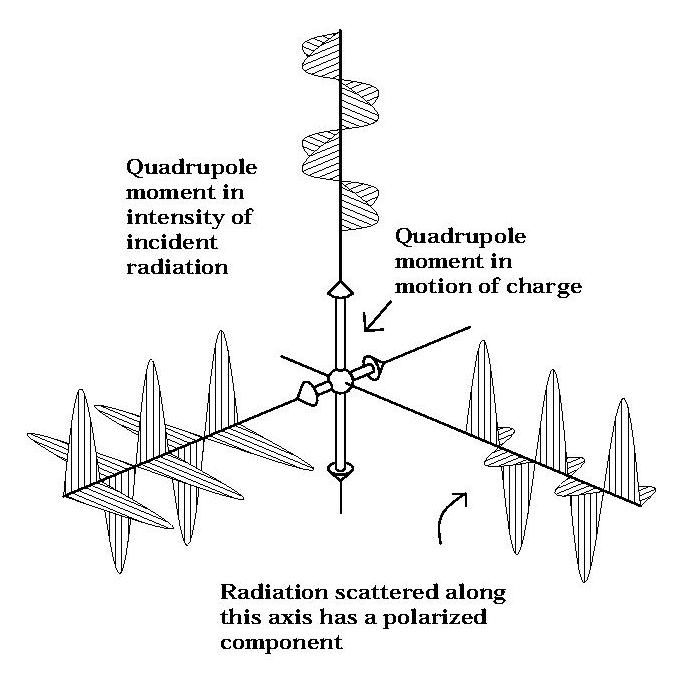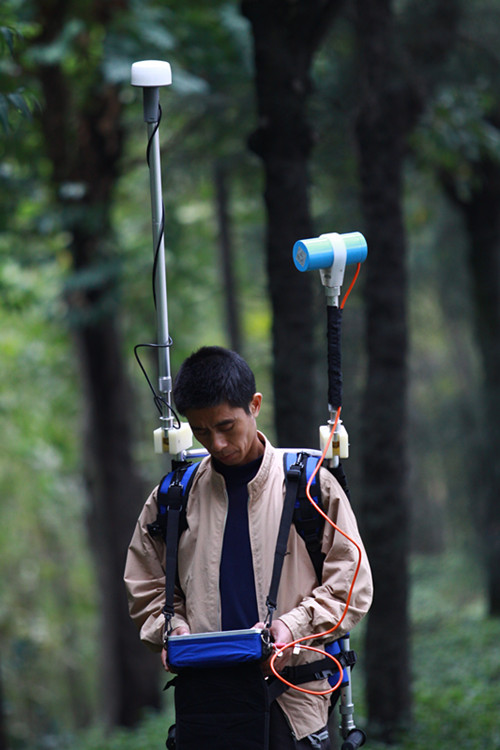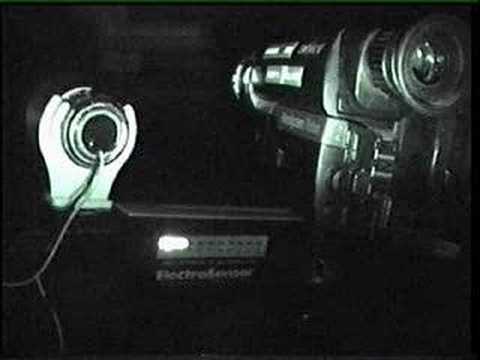Meters, Measuring and Science
 Monday, August 13, 2012 at 9:42AM
Monday, August 13, 2012 at 9:42AM 
Measuring Science
One of the fundamentals of almost every investigative method for paranormal research is that of the radiological survey.
When it was first possible to measure environmental conditions, university researchers set about surveying a site for any possible environmental factor that could account for the paranormal phenomena and inadvertantly identified a multitude of possible factors.
While there are a number of psychological factors that could account for reported paranormal phenomena, environmental scientists discovered even more potential causes including radiation.
Everything in the universe has an Electromagnetic Field or EMF. The Earth has a DC field called the 'Geomagnetosphere' that protects us from solar radiation. Artificial sources like powerlines, electronics and such have larger AC fields. Even our bodies have a natural DC field (and an Electrostatic field) that are easily measurable. The affects of these fields and on these fields have led to many advancements but why would these have any affect on paranormal claims?
Radiation that can cause phsyiological and psychological alterations at a site consist of Electromagnetic Radiation (both AC and DC), Electrostatic, Radio Frequency and Ionizing radiation like Alpha, Beta, Gamma and X-Ray. All of these forms of radiation have a presence in modern environments and all can result in what is termed Electromagnetic Hypersensitivity or Electromagnetic Poisoning. It is this poisoning that can lead an unaware subject to believe that they are experiencing paranormal phenomena.
Electromagnetic Poisoning Symptoms:
- chronic fatigue
- daily headaches
- insomnia
- allergies
- high blood pressure
- brain fog
- ADD/ADHD
- migraine headaches
- lymphoblastic leukemia
- miscarriages
- stress
- nausea
- fatigue
- skin conditions – burning, rashes, pain
- tinnitus and other audible noises
- chronic pain
- erratic pulse
- weak immune system
- Hallucinations
These are just some of the symptoms that one can experience when subjected to excessive amounts of Electromagnetic Radiation. By identifying the radiation in the environment, it is possible to identify the potential sources of the "paranormal" activity. This is not to say all paranormal phenomena are simply excessive radiation but the large majority of studies have identified that what does not come from a routine source may be detectable as a radiological anomaly.
Identifying potential environmental radiation and radiological anomalies are environmental science at it's finest. Physics scientists, environmental scientests, environmental geologists and environmental survey technicians study these fields and their effects every day. This is also where ghost hunters have adopted environmental survey techniques, the actual science that permits them to validate or invalidate claims from a scientific standpoint.
EMF Meters
Since ghost hunting and paranormal investigating hit the mainstream, everyone learns that you need an EMF Meter to hunt for ghosts. It's also at this point where skeptics jump up and say these devices do not detect ghosts, there is NO Science in what you are doing.
This is both true and false at the same time.
Knowing the effects electromagnetic radition can have on a person gives a researcher something to measure for, something to look for in the environment. Through a radiological survey it is possible to scientifically identify with some certainty what 'could' be the cause of some accounts. It is also important to note that NO meter is capable of detecting ghosts. Anomalies identified through a survey are just that, radiological anomalies.
If an EMF meter is used properly, then it is possible to identify potential sources and any anomalies that are within the environment.
EMF Meter vs EMF Detector
Nothing is more frustrating as a researcher than having amateur ghost hunters and would-be researchers referring to their technology based on what they've learned from TV shows. If you want to be taken seriously as a researcher, learn the science.
- EMF Meter - An EMF meter is any radiological survey device that 'measures' and provides some means of identifying field strength intensity.
- EMF Detector - An EMF Detector is any radiological survey device that can 'identify' a field and indicate the basic intensity (not a measured strength).
Many individuals always tend to argue their point both about this and the term 'debunk' but always fail to see the point. Anyone that wants to hold their work as credible strives to provide little ammunition for skeptics. Failing to understand professional terminology is the first step toward discrediting your work for any skeptic.
EMF Meter Usage
Using an EMF meter properly, or any radiological survey device for that matter, is greatly dependant on understanding the capabilities of the device, the specifications and the intended useage.
 For instance the most common device is the Lutron 822-A EMF meter, this device measures on a single axis across the 30 - 400hz AC field and is designed to measure accurately 50/60hz range in either Milligauss or MicroTesla with accuracy of 4% at that range. This means it is the most accurate when measuring AC or artificial fields and loses accuracy depending on the frequency above and below that intended usage. Single Axis also means that the meter needs to be rotated to meaure on all 3 Axis.
For instance the most common device is the Lutron 822-A EMF meter, this device measures on a single axis across the 30 - 400hz AC field and is designed to measure accurately 50/60hz range in either Milligauss or MicroTesla with accuracy of 4% at that range. This means it is the most accurate when measuring AC or artificial fields and loses accuracy depending on the frequency above and below that intended usage. Single Axis also means that the meter needs to be rotated to meaure on all 3 Axis.
Depending on the model, a survey meter may measure on multiple axis or it may require you to manually rotate to measure for the peak field strength.
DC EMF meters work on a very similar principle and scale however, most of these devices are subject to interference from other natural fields within the environment. These require extensive training and time to use properly to survey a site.
Another device may be an electrostatic monitor or an Air Ion counter. These measure ions as parts-per-millionth (ppm) and determine the calculated microvoltage. There are no axis to meaure with these as they measure by contact with a field.
Still, another type of meter may measure for classic raditiaton like Alpha, Beta, Gamma or X-Rays and in many instances these devices are limited in which 'band' they are measuring for in the field. The more fields that a radiological meter measures the more the accuracy of those measurements decrease.
Capacitor Circuit vs Magnetometer
The two most prominent types of devices in paranormal research at the moment are based on one of two types of technology, either a capacitive circuit or a magnetomer.
 Capacitive Circuit - A capacitor circuit measures the change in the field of the capacitor as the energy moves the field on the electroplate. Many 'detectors' including the K-2, K II 'meters' use a capacitive circuit, the downside is that capacitive circuits can be influenced by any field effectively invalidating any results.
Capacitive Circuit - A capacitor circuit measures the change in the field of the capacitor as the energy moves the field on the electroplate. Many 'detectors' including the K-2, K II 'meters' use a capacitive circuit, the downside is that capacitive circuits can be influenced by any field effectively invalidating any results.- Magnetometer - A magnetometer circuit comes in one of three forms; Vector, Ring Core and Search Coil sensors. The principle is a sensitive metal is pulled in a direction and the pull is measured to determine field strength. These are ALL EMF meters. This means that any sudden movement can cause changes in readings and if the motion is strong enough it could cause calibration issues.
Survey - A survey is conducted by holding the survey meter aproxiamtely 20inches from the body, stopping every 3-5ft and slowly moving in sweeping motions before advancing. If it is single axis or dual-axis it may require you to roatate the meter as you 'sweep.' Once a peak is identified that measurement it then followed to identify its source.
It is very important to note that most hand-held meters suffer from accuracy issues and may produce different results when surveying a site multiple times. External factors like elctricity pulses in the lines, saturation of the meter's circuits and even weather conditions can affect the accuracy of these devices. If you're measuring for AC EMF fields, Electrostatic or RF there are countless contamination sources that could throw-off measurements and accuracy during a survey. Even additional electronics in hand can affect a sensor decreasing the accuracy of your survey.
Geophysicists utilize magetometers routinely and to assure their accuracy these devices are quite large, a 20-30lb backpack array, a tablet computer and a large sensor that is on a pole 5-6ft off the ground to prevent contamination. Surveys are conducted by stopping to take readings every 3-6ft in a grid-like pattern. You may have a handheld unit but just remember accuracy is an issue with those units.
Flashy Ghost Hunting
The most scientific part of ghost hunting is the environmental survey but many regard it with awe when the ghost hunter takes out that unusual looking device with all of the blinking lights. To the lay-person this is the most interesting part of ghost hunting and to a degree it's what ghost hunters like as well. In all honesty, every paranormal investigator wants their own version of a proton pack.
In reality, conducting a site survey with EMF meters and other radiological survey meters is a very dull and laborious process.
- You estabilsh a 'baseline' for the site and make note of what would be a variation over or below that measurement.
- You systematically divide up the site, thinking of the layout in a grid.
- You follow that grid tracing readings within that space.
- You do not immediately measure electronics based on assumptions. (Accurate measurments will guide you to the source within that space).
- Decrease the interference with the survey by reducing potential radiation sources. (ie electronics on your person, contamination sources like wifi, radios etc.)
- Any fields that cannot have a source identified are noted as anomalies.
Following this basic survey method will assure the most accurate results and validate potential EMF Poisoning sources. Sadly, this is also where amateur ghost hunters can fail miserably by invalidating their own results in favor of flash.
The Proton Pack Approach
 A lot of investigators want to have something flashy, their own proton pack or they just want to minimize their time spent doing a survey. So, these investigators will resort to carrying multiple electronics while conducting a survey or they will combine electronics into one device this effectively in-validates any readings with the device.
A lot of investigators want to have something flashy, their own proton pack or they just want to minimize their time spent doing a survey. So, these investigators will resort to carrying multiple electronics while conducting a survey or they will combine electronics into one device this effectively in-validates any readings with the device.
Quite often, creative investigators will take kids toys like the Eyclops Night Vision gogles and add an EMF meter to it (in this case an electro-sensor) to simplify the survey and make it 'flash.' The accuracy of the EMF meter is already questionable and adding electronics to it only assures that the device will never accurately measure. 
Any readings taken when devices are combined like the eyclops/electrosensor or the camcorder/electrosensor are open to skeptics to discredit because of the inaccuracies of those readings.
If you are attempting a scientific approach to your ghost hunting then it is necessary to understand your technology, the methods and techniques required. It is very dull but you will have valid data. If you're after your own proton pack-style then expect skeptics to discredit your methods immediately. You are using a kids toy after-all.
Finally, if the dry radiological survey doesn't sound like your style then you may want to consider a different method altogether, maybe a documentarian?






Reader Comments